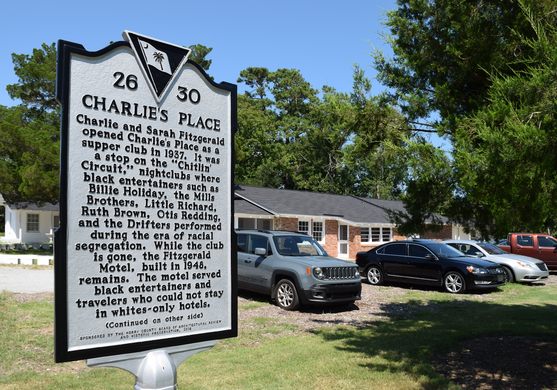AO Edited
Site of Charlie’s Place
Once a safe haven for Black patrons and performers—including Billie Holiday and Duke Ellington—during the Jim Crow era, portions of this nightclub and motel have been restored to welcome a new kind of visitor.
From the late 1930s through the early ‘60s, Charlie’s Place was a prominent stop on the ‘Chitlin Circuit,’ an informal collection of Black-centered entertainment venues that included juke joints, clubs, and theaters. It was also the spot to be along Carver Street in Myrtle Beach’s Booker T. Washington neighborhood—a bastion of Black American history.
Black entrepreneur Charlie Fitzgerald and his wife Sarah opened Charlie’s Place as a supper club in 1937, and it soon became a space for not only Black performers, but also for Black patrons to come and hear incredible music (often alongside whites) while temporarily escaping the oppressiveness of the era. Next door sat the Fitzgerald home and a small motel, The Fitzgerald, which the couple opened in 1948. The motel provided a place for black entertainers to stay between performances, and was even featured (along with Charlie’s Place) in the 1953 Green Book “airline edition”—a guidebook highlighting safe places where black travelers could stay and eat countrywide.
The lively nightclub (and eventually, its adjacent motel) attracted a bevy of notable artists, including Dizzy Gillespie, Little Richard, Billie Holiday, and Duke Ellington, in the days prior to integration. According to oral tradition, it’s also where the Shag, a form of southern swing dancing that also happens to be South Carolina’s official state dance, originated.
But not all of the history of this place was positive. On August 26, 1950, 26 cars of armed Ku Klux Klan members surrounded the club and fired hundreds of rounds into Charlie’s Place, seriously injuring several patrons. Fitzgerald himself was severely beaten, though eventually recovered. While some Klansmen were charged, no one was ever prosecuted.
In 2017, the city of Myrtle Beach purchased the collective Charlie’s Place property and began a project to preserve its musical and collective history. Although the nightclub itself is long gone, a plaque marks the site, and both the home and a part of the motel remain. The city has restored what’s left of the structures to serve as a community center and event space, as well as a museum to the era, with a few of the motel rooms reappearing as they were during racial segregation and serving as a small museum, and four others being used as entrepreneurial incubators. The site also hosts various festivals and events, including October’s three-day Myrtle Beach Jazz Festival.
In June of 2021, Charlie’s Place became part of the African American Civil Rights Network, a collection of properties, programs, and facilities that tell the stories of the U.S. civil rights movement nationwide.
Know Before You Go
The city of Myrtle Beach hosts free tours of the Charlie’s Place property on Tuesdays and Fridays from 12:30 p.m. to 2:30 p.m. Call 843-918-1062 or send an email to neighborhoodservices@cityofmyrtlebeach.com for more info.
Combine it with a visit to the nearby Historic Myrtle Beach Colored School Museum & Education Center, which provides a glimpse into what school life in Myrtle Beach was like for African Americans between 1932-1953
For a deeper delve into Charlie’s Place, don’t miss the Emmy-winning short documentary, “Charlie’s Place” available online at www.pbs.org or here.

















Follow us on Twitter to get the latest on the world's hidden wonders.
Like us on Facebook to get the latest on the world's hidden wonders.
Follow us on Twitter Like us on Facebook